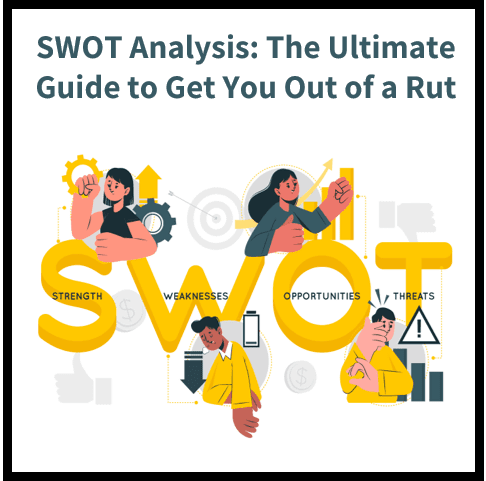The strength of your company’s internal strengths and weaknesses directly impacts your ability to achieve business success. A SWOT analysis is a strategic planning tool that helps you analyze the strengths, weaknesses, opportunities, and threats that your business faces. It’s one of the primary tools businesses use to identify opportunities and risks before making a decision on how to proceed. A SWOT analysis is also useful for identifying whether there are any obvious red flags or areas where you need to do more research. WING Analysis (SWOT Analysis) is an exploratory technique used in organizational studies and business management to analyze the ‘strength, weakness, opportunity and threat’ factors of a company or an organization. Keeping these factors in mind while taking any strategy decision will help in achieving desired results. Let’s take a look at how you can create a WING Analysis for your own business using these 5 steps:
What is a SWOT Analysis?
A SWOT analysis is a strategic planning tool that helps you analyze the strengths, weaknesses, opportunities, and threats that your business faces. It’s one of the primary tools businesses use to identify opportunities and risks before making a decision on how to proceed. A SWOT analysis is also useful for identifying whether there are any obvious red flags or areas where you need to do more research. The strengths, weaknesses, opportunities, and threats will depend on your company’s context, including its current situation, resources, and the environment in which it operates.
Step 1: Define Your Company’s Mission and Vision
Begin your SWOT analysis by defining your overall business mission and vision to provide guidance throughout the remainder of the process. Your mission statement should be clear, concise, and relevant to your business and goals. Your business vision statement, on the other hand, should be compelling, ambitious, and inspiring. It should also leave room for growth and change as your company and industry evolve. Your mission and vision statements are the foundation for all other components of your SWOT analysis. They provide context for identifying your company’s strengths and weaknesses and also inform how you might go about capitalizing on opportunities and addressing threats.
Step 2: Assessing Strengths and Weaknesses
For each of your business’s core functions and aspects (e.g., marketing, finance, etc.), conduct a thorough review to identify the strengths and weaknesses. Be sure to evaluate the past, present, and future. Think about the resources and capabilities that are needed to succeed in each area. If you’re having difficulty identifying your company’s strengths and weaknesses, start with these questions: As you assess your company’s strengths, keep in mind that you are looking for internal strengths. Your strengths are the elements that are under your direct control. Think about factors such as your team’s expertise, your brand, your proprietary technology, and your internal processes. As you assess your company’s weaknesses, think about factors that are outside of your control. Weaknesses are the areas where you need to do more research or hire a consultant to help you improve. It can be helpful to list your strengths and weaknesses separately. This will allow you to more easily identify where you can capitalize on your strengths and where you should focus to address your weaknesses.
Step 3: Identifying Opportunities and Threats
Afterconducting an assessment of your company’s strengths and weaknesses, you can proceed to identify opportunities and threats. The opportunities and threats will depend on your company’s context, including its current situation, resources, and the environment in which it operates. For example, if the economy in your region is growing, that can be an opportunity because it means more people are spending money on your products or services. On the other hand, if interest rates are rising, that can be a threat because it would increase the cost of your future borrowing.
Step 4: Finding the root cause of opportunities and threats
After listing the opportunities and threats as you identified them, you can proceed to find the root causes of each of them. This will help you understand the situation in a deeper way and assist you in coming up with solutions. For example, if you list rising interest rates as a threat, you can dig a little deeper to understand why rates are rising. From there, you may conclude that rising interest rates are primarily the result of a growing economy. Once you understand the root cause of your threats and opportunities, you can proceed to address them by formulating a solution or strategy.
Step 4: Confirm Your Findings With a Risk Assessment
Finally, you can confirm your findings with a risk assessment. This step is optional, but it can be helpful if you want to gain a better understanding of the red flags your SWOT analysis has uncovered. For example, if you list increasing competition as a threat, you can use a risk assessment to understand the likelihood that competitors will enter your market and the potential impact that will have on your company. A risk assessment can be helpful for businesses at any stage. If you are just starting out, it will help you anticipate the future. If you are running a successful business, it can provide insight into areas where you need to do more work.
Step 5: Create a Strategic Plan Based On Your Analysis
Once you have completed your SWOT analysis, you can proceed to create a strategic plan based on your findings. Begin by identifying the areas where you have strengths, weaknesses, opportunities, and threats. When you have all four of these elements, you can proceed to create a strategic plan. Next, identify the type of business you are in and decide what the primary goal of your business is. From there, you can proceed to create a mission statement, identify your goals and objectives, and develop a strategy to achieve them.
Conclusion
A SWOT analysis is a strategic planning tool that helps you analyze the strengths, weaknesses, opportunities, and threats that your business faces. It’s one of the primary tools businesses use to identify opportunities and risks before making a decision on how to proceed. A SWOT analysis is also useful for identifying whether there are any obvious red flags or areas where you need to do more research. The strengths, weaknesses, opportunities, and threats will depend on your company’s context, including its current situation, resources, and the environment in which it operates. When you conduct a SWOT analysis, you are not only assessing your company’s strengths and weaknesses, but also identifying opportunities and threats that can help you make strategic decisions for your company.






35 thoughts on “SWOT Analysis: The Ultimate Strategy Guide to Get You Out of a Rut”
… [Trackback]
[…] Read More on that Topic: skillfine.com/swot-analysis-strategy-guide-out-of-a-rut/ […]
… [Trackback]
[…] Read More on to that Topic: skillfine.com/swot-analysis-strategy-guide-out-of-a-rut/ […]
… [Trackback]
[…] Read More on to that Topic: skillfine.com/swot-analysis-strategy-guide-out-of-a-rut/ […]
… [Trackback]
[…] There you can find 76277 more Information on that Topic: skillfine.com/swot-analysis-strategy-guide-out-of-a-rut/ […]
… [Trackback]
[…] Info to that Topic: skillfine.com/swot-analysis-strategy-guide-out-of-a-rut/ […]
… [Trackback]
[…] Read More here to that Topic: skillfine.com/swot-analysis-strategy-guide-out-of-a-rut/ […]
… [Trackback]
[…] Read More to that Topic: skillfine.com/swot-analysis-strategy-guide-out-of-a-rut/ […]
… [Trackback]
[…] Info to that Topic: skillfine.com/swot-analysis-strategy-guide-out-of-a-rut/ […]
… [Trackback]
[…] Find More here on that Topic: skillfine.com/swot-analysis-strategy-guide-out-of-a-rut/ […]
… [Trackback]
[…] Find More on on that Topic: skillfine.com/swot-analysis-strategy-guide-out-of-a-rut/ […]
… [Trackback]
[…] Read More to that Topic: skillfine.com/swot-analysis-strategy-guide-out-of-a-rut/ […]
… [Trackback]
[…] Read More on on that Topic: skillfine.com/swot-analysis-strategy-guide-out-of-a-rut/ […]
… [Trackback]
[…] Find More here on that Topic: skillfine.com/swot-analysis-strategy-guide-out-of-a-rut/ […]
… [Trackback]
[…] Find More to that Topic: skillfine.com/swot-analysis-strategy-guide-out-of-a-rut/ […]
… [Trackback]
[…] Info to that Topic: skillfine.com/swot-analysis-strategy-guide-out-of-a-rut/ […]
… [Trackback]
[…] Find More on that Topic: skillfine.com/swot-analysis-strategy-guide-out-of-a-rut/ […]
… [Trackback]
[…] Find More on that Topic: skillfine.com/swot-analysis-strategy-guide-out-of-a-rut/ […]
… [Trackback]
[…] Read More Information here on that Topic: skillfine.com/swot-analysis-strategy-guide-out-of-a-rut/ […]
… [Trackback]
[…] Find More here to that Topic: skillfine.com/swot-analysis-strategy-guide-out-of-a-rut/ […]
… [Trackback]
[…] Here you can find 55764 more Information on that Topic: skillfine.com/swot-analysis-strategy-guide-out-of-a-rut/ […]
… [Trackback]
[…] Information on that Topic: skillfine.com/swot-analysis-strategy-guide-out-of-a-rut/ […]
… [Trackback]
[…] Read More here on that Topic: skillfine.com/swot-analysis-strategy-guide-out-of-a-rut/ […]
… [Trackback]
[…] There you will find 37479 more Information on that Topic: skillfine.com/swot-analysis-strategy-guide-out-of-a-rut/ […]
… [Trackback]
[…] Read More Information here to that Topic: skillfine.com/swot-analysis-strategy-guide-out-of-a-rut/ […]
… [Trackback]
[…] Here you can find 29335 more Information on that Topic: skillfine.com/swot-analysis-strategy-guide-out-of-a-rut/ […]
… [Trackback]
[…] Find More to that Topic: skillfine.com/swot-analysis-strategy-guide-out-of-a-rut/ […]
… [Trackback]
[…] Information to that Topic: skillfine.com/swot-analysis-strategy-guide-out-of-a-rut/ […]
… [Trackback]
[…] Read More on on that Topic: skillfine.com/swot-analysis-strategy-guide-out-of-a-rut/ […]
… [Trackback]
[…] Here you can find 38092 more Information on that Topic: skillfine.com/swot-analysis-strategy-guide-out-of-a-rut/ […]
This is a very insightful guide on SWOT analysis. Thank you for the information!
Your point of view caught my eye and was very interesting. Thanks. I have a question for you.
Can you be more specific about the content of your article? After reading it, I still have some doubts. Hope you can help me.
I really like reading through a post that can make men and women think. Also, thank you for allowing me to comment!
702483 557053great work Outstanding weblog here! Also your internet site a whole lot up quick! What web host are you the usage of? Can I get your associate link on your host? I want my web site loaded up as fast as yours lol 858164
745592 511113This sort of considering develop change in an individuals llife, building our Chicago Pounds reduction going on a diet model are a wide actions toward making the fact goal in mind. lose weight 815726